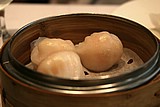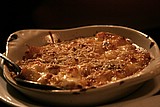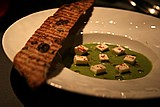Home |
Restaurants by City
|
Food Photography |
Archive | Philosophy |
![]()
Right now we are eating in Seattle, Washington.
|
Wednesday
2004
Permalink
|
Doughnut Plant, New York, New York, tasted on February 21, 2004 Growing up in Boston you don't really have a sense of what value the rest of the world places on donuts. It's not that they aren't appreciated elsewhere, it's simply that they aren't appreciate quite as much. It is said (mostly by me) that you can't sneeze without bumping into a donut shop in Boston. And since the Department of Justice has yet to get interested, Dunkin Donuts appears to have a monopolistic stranglehold on the Boston donut market. And while I recognize that my childhood may have colored my opinion of those donuts (and even my stubborn insistence at using "donut" instead of "doughnut"), I still say they are quite delicious. They don't have the sickly sweet flavor of a Krispy Kreme (is there any flour to be found amidst all that butter and sugar?), nor do they have the heavy cakey quality of some of the other donut chains I've had. Just a perfect balance of sugar and buttery dough that comes in a large variety of flavors. And while my love for Dunkin Donuts is everlasting, our relationship is certainly not monogamous. This is why the prospect of trying out some donuts from the darling of the New York donut scene - Doughnut Plant - filled me with excitement. What would a "gourmet" donut taste like? Would it be too "foofy"? Would the donut refined spoil my love of the more pedestrian Dunkin variety? Let's find out. Doughnut Plant certainly met my imagination's vision of what a refined donut maker should look like. A no frills, utilitarian storefront where all the energy in the small establishment is being directed at making great donuts with a simple approach valuing high quality ingredients. We tasted quite a variety including: Vanilla Valhrona Chocolate, Rosewater Rose Petal, Banana Pecan, and Grapefruit. Each donut started as the same item - a relatively large ring of dough that's light, filled with air pockets, and has almost an eggy quality (though I was assured several times there is no egg in their recipe, just 100% corn oil and "lots of love" - this website is probably not the place to comment on other recipes that use 100% corn oil and "lots of love"). The glazes are all rich, sugary, and almost dripping off the sides of the donut. There were no fillings, and the glazes were all organic using fruits and nuts for flavor. The grapefruit variety just had juice, pulp, and zest added to the glaze before it was applied to the donuts. Its essence was captured in the glaze. We also tried some non-donut pastries including a Sticky Bun with Fresh Roasted Pecans, and a Churro. Both were excellent. Mark Isreal, the owner and founder took a couple of minutes to chat with us about his excellent donuts. His grandfather Herman's picture looks over the whole operation which it appears is booming. At the time we spoke he was already selling his donuts to 40 stores in the area, and since we spoke he's opened a branch in Tokyo. What can I say, though the donuts were a little large for me (Mark explained "we like it big") the love they put into making them is definitely apparent. Why the simple formula of focusing deeply and passionately on a small set of things and doing them the best they can be done isn't copied more I don't know. But in the meantime, Doughnut Plant really makes some of the highest quality, and tastiest, donuts I've ever eaten. And while I was assured they could do special orders to make small ones, I kind of like experiencing them the way the folks at Doughnut Plant intended - large in size and overwhelmingly tasty.
|
|||
Our Sponsors
Online Loans Conversion Strategies College Courses Surprise Birthdays Online Trading - Calendar and Event Schedules - Food Events and Calendars - Wine Events and Calendars - Digital Photography Resources - Jewish Gifts and Judaica - Howard Stern Podcast ponytailed blogger Jonathan Schwartz

Browse tastingmenu
Home |
Restaurants by City X |
Food Photography |
Archive | Philosophy |
![]()
Free eBooks: All About Apples
| Autumn Omakase
More:
Discussion |
Cool Food T-Shirts |
Ingredients
| Markets |
Recipes
Search |
Blog FAQ |
Other
Blogs
Best of tastingmenu
|
City View
Entry: July 6, 2006 |
Blue Plate
Entry: June 19, 2006 |
L'Atelier de Joël Robuchon
Entry: July 18, 2006 |
Browse by City
Boston | Chicago | Houston | Las Vegas | Los Angeles | Maui | New York | Philadelphia | Portland | San Francisco | Seattle | Toronto | Utah | Vancouver | Washington D.C.
Bangkok | Beijing | Hong Kong | Seoul | Tokyo
Amsterdam | Berlin | Italy | London | Madrid | Paris | Vienna
Browse by Month
2006
2005
2004
2003
2002
2001
Comments, questions, or feedback:
info / at / tastingmenu / dot / com
All pages Copyright (c) 2001-2006 tastingmenu.com
Last modified 11/27/06.




